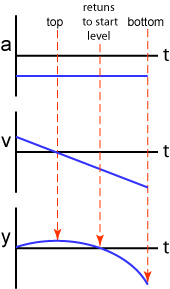|
Mr. Rogers' AP Physics C: Kinematics Problems |
Solution
Define downward as negative. Clearly, the acceleration is constant so the a vs.t, v vs. t, x vs. t are as shown at bottom right.
|
|
|||||||||||||||||||||||||||||||||||||||||||||||||||||||||||||||||||||||||||||||||||||||||||||||||||||||||
The final speed of the coin is greater than the starting speed because it falls to a position below the starting position. If it fell back to the same position, the speed would be identical to the starting speed.
Metacognition Questions:
Do the number of unknowns match the number of equations? Most problems in physics including the type illustrated above are solved by simply writing enough equations so that the number of unknowns equals the number of equations. The equations can then be solved simultaneously.
Is the acceleration constant? With constant acceleration there are essentially just two equations that can be written:
| v | = at + vo | |
| x | = 1/2at2 + vo t + xo |
However, these equations are only valid for constant acceleration.
